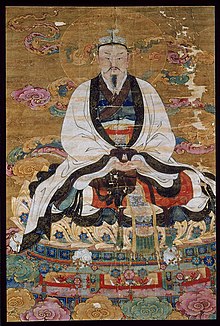Jade Emperor
The Jade Emperor (Chinese: 玉皇; pinyin: Yù Huáng or 玉帝, Yù Dì) is one of the representations of the first god (太帝 tài dì) in Chinese mythology and religion. In Daoist theology, he is associated with Yuanshi Tianzun, one of the Three Pure Ones. He is also the Cao Đài ("Highest Power") of Caodaism. He is often identified with Śakra in Chinese Buddhist cosmology.[1][2][3][4] In Korean mythology, he is known as Haneullim.[1][5][6]
| Jade Emperor | |||||||||||
 Jade Emperor in a Ming Dynasty ink and color painting on silk, 16th century | |||||||||||
| Chinese | 玉皇 | ||||||||||
|---|---|---|---|---|---|---|---|---|---|---|---|
| Literal meaning | Jade Emperor | ||||||||||
| |||||||||||
| Second alternative Chinese name | |||||||||||
| Chinese | 天公 | ||||||||||
| Literal meaning | Heavenly Grandfather | ||||||||||
| |||||||||||
| Third alternative Chinese name | |||||||||||
| Chinese | 玉皇大帝 | ||||||||||
| Literal meaning | August Emperor of Jade | ||||||||||
| |||||||||||
The Jade Emperor is known by many names. Some names include (1) the Heavenly Grandfather (天公, Tiān Gōng), which originally meant "Heavenly Duke", (2) the Jade Lord; (3) the Highest Emperor; (4) Great Emperor of Jade (玉皇上帝, Yu Huang Shangdi or 玉皇大帝, Yu Huang Dadi).[1][6]
Mythology
changeThe Jade Emperor was originally the assistant of the Divine Master of the Heavenly Origin, Yuanshi Tianzun. Yuanshi Tianzun is the supreme beginning, the limitless and eternal creator of Heaven and Earth. He picked Yu-huang, or the Jade Emperor, as his personal successor.[1][6]
The Jade Emperor will later be succeeded by the Heavenly Master of the Dawn of Jade of the Golden Door (金闕玉晨天尊).[7] The characters for both are shown on the front of the arms of his throne.[1][6]
In two traditional writing texts produced in 1925 and 1972, Guan Yu became the 18th Jade Emperor in about 1840 AD.[8][9] However, some have disagreed that Guan Yu has succeeded. And thus the Jade Emperor and Guan Yu are often worshiped separately.[10] In Tienti teaching, the ruling Jade Emperor has 55 predecessors.[11] However, this is from the opinion of the Chinese folk religion. Many Taoists do not believe these claims to be true.[1][6]
Festivals
changeThe Jade Emperor's Birthday (天公誕) falls on the ninth day of the first lunar month.[12] On this day, Taoist temples perform a Jade Emperor ritual (拜天公, bài Tiān Gōng, literally "heaven worship"). In this, priests and common people lie straight on the ground, burn incenses and make food offerings.[1][6]
References
change- ↑ 1.0 1.1 1.2 1.3 1.4 1.5 1.6 "Living in the Chinese Cosmos | Asia for Educators". afe.easia.columbia.edu. Retrieved 2021-11-30.
- ↑ "Yudi | Chinese deity | Britannica". www.britannica.com. Retrieved 2021-11-30.
- ↑ Stevens, Keith (1989). "The Jade Emperor and His Family 玉皇大帝 Yu Huang Ta Ti". Journal of the Hong Kong Branch of the Royal Asiatic Society. 29: 18–33. JSTOR 23890811.
- ↑ Eng, Khoo Boo (2014-04-01). A Simple Approach To Taoism. Partridge Singapore. ISBN 978-1-4828-9530-8.
- ↑ The Annals of King T'aejo: Founder of Korea's Chosŏn Dynasty. Harvard University Press. 2014-06-09. ISBN 978-0-674-28130-1.
- ↑ 6.0 6.1 6.2 6.3 6.4 6.5 "Jade Emperor". World History Encyclopedia. Retrieved 2021-11-30.
- ↑ 道教的神 Archived 2010-05-19 at the Wayback Machine
- ↑ 關聖帝君受禪玉帝經略 Archived 2011-07-17 at the Wayback Machine
- ↑ "瑤池聖誌 目錄". www.boder.idv.tw. Retrieved 2021-11-30.
- ↑ "寫給天道道親的一封信". Archived from the original on 2017-11-24. Retrieved 2009-11-14.
- ↑ 教源──道統衍流 天帝立教道統衍流 Archived 2008-08-21 at the Wayback Machine
- ↑ Lin Meirong (2011). "Jade Emperor". Encyclopedia of Taiwan. Council for Cultural Affairs. Archived from the original on 22 February 2014. Retrieved 12 September 2012.